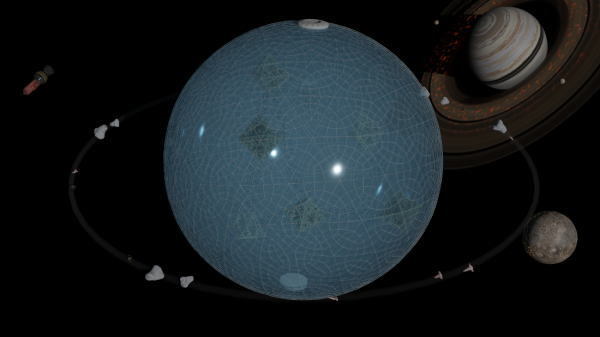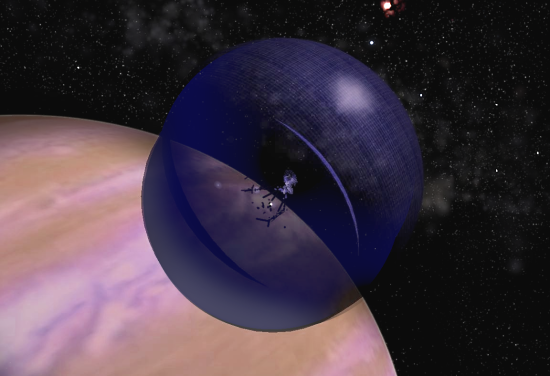BY LETTER
Freesphere
Technology > Technology Type or Material > Drytech/Hylotech
Technology > Technology Levels > High Tech / Hitech
Technology > Application > Infrastructure
Technology > Technology Levels > High Tech / Hitech
Technology > Application > Infrastructure
Inflated free fall habitat | |
 Image from Lilly Harper | |
| A freesphere is a large inflatable microgravity environment containing a breathable atmosphere. | |
Freespheres are large, transparent, double-walled open bubbles, ranging from several hundred meters to several thousand kilometers across, filled with air. Appropriately modified lifeforms create a free-fall ecology and a layer of water between the inner and outer walls, combined with magnetic screening, provides an effective radiation shield. Freespheres are especially popular when placed in planetary orbit due to both the spectacular views and the sense of truly flying 'above' something rather than merely floating in space.
For freesphere diameters greater than 100km, stronger materials and additional re-enforcing structures are required. This reinforcement attenuates the views, as does the longer sight lines through the internal atmosphere, but with a hull completely made of buckycables a Freesphere can be made much larger than a rotating habitat made of the same material; as large as 5,000 km across even with full, baseline comfortable, atmospheric pressure.
Freespheres may employ complex internal environmental systems, including airwalls, fusion- or conversion reactor-powered artificial suns, and various feedback-based systems to promote airflow, control temperature, and manage both general humidity and larger concentrations of moisture (ranging from small "pools" to "seas" several kilometers across).
 Image from Steve Bowers | |
| This Freesphere, in orbit around Hiederia, holds a number of freeform microgravity structures which serve as habitats and workshops for the low-gravity tweaks who live there | |
Both gravity balloons and freespheres may include habitable components which rotate to produce gravity, and these structures are generally tethered to an internal structure to ensure they remain in place and do not collide with other structures in the environment. Because the rotation of these habitats can cause wind eddies, the rotation rate and subsequent gravity is generally kept quite low.
Related Articles
- Ederworlds
- Gravity Balloons
- Hiederia
- Microgravity - Text by M. Alan Kazlev
A state in which gravity is reduced to virtually negligible levels. For example, when an object is in free fall, it experiences microgravity. It is deleterious to baseline physiology, but space-adapted tweaks can survive a microgravity environment indefinitely. - Microgravity Art - Text by Anders Sandberg
Art that requires micro- or zero- gravity to retain its configuration. Fragile sculptures are popular, some including liquids in interesting configurations. The only problem to deal with is air drafts. - Microgravity Space Habitats
- Niven Clouds (Smoke Rings)
- Non-Luminary World Classification Scheme
- Space Adapted Human
- Space People - Text by M. Alan Kazlev
[1] (archaic) A common early term for Space Adapted Humans, still used by some descendants of the original clade.
[2] (Integration period) A term for vacuum adapted tweaks, now rarely used.
Appears in Topics
Development Notes
Text by Todd Drashner
Additional material by Steve Bowers
Initially published on 02 February 2002.
Additional material by Steve Bowers
Initially published on 02 February 2002.
Additional Information
Fiction relation to Freespheres
Traveler's Notes: Freesphere
Traveler's Notes: Freesphere






